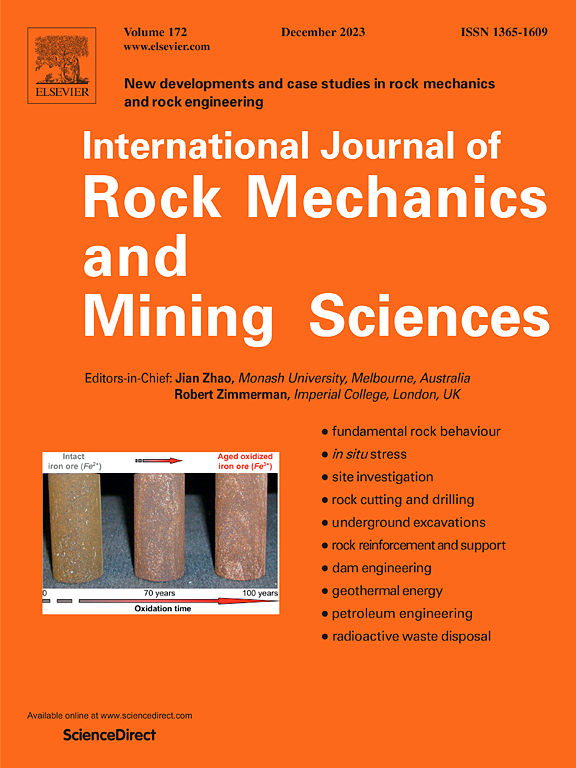多孔岩石中晶粒破碎的能量驱动破碎-塑性耦合模型
IF 7
1区 工程技术
Q1 ENGINEERING, GEOLOGICAL
International Journal of Rock Mechanics and Mining Sciences
Pub Date : 2024-10-25
DOI:10.1016/j.ijrmms.2024.105931
引用次数: 0
摘要
这项研究开发了一种能量驱动构造模型,旨在解决多孔岩石中晶粒破碎的复杂现象。首先,提出了一种新颖的耦合关系,利用球极坐标整合各种能量耗散机制,包括塑性效应和挤压效应。这种方法实现了能量耗散的稳健耦合,全面描述了晶粒破碎对塑性变形的影响。然后,通过将弹性势能等值线与实验结果进行比较,制定了基于能量的屈服标准,并通过能量演化研究了压碎硬化的行为。随后推导出流动规则,既包括独立的流动规则,也包括考虑塑性-挤压耦合的流动规则。最后,根据一系列实验测试进行验证,突出了模型的多功能性。所提出的模型从能量角度加强了对岩石破碎问题的理解,并且只需 4 或 5 个易于校准的参数就能显示出其简易性。本文章由计算机程序翻译,如有差异,请以英文原文为准。
An energy-driven crushing-plasticity coupling model for grain crushing in porous rocks
This research develops an energy-driven constitutive model designed to tackle the complex phenomenon of grain crushing in porous rocks. Initially, a novel coupled relationship is proposed to integrate various energy dissipation mechanisms, including both plastic and crushing effects, using spherical polar coordinates. This approach results in a robust coupling of energy dissipation, providing a comprehensive depiction of the influence of grain crushing on plastic deformation. An energy-based yield criterion is then formulated by comparing elastic potential energy contours with experimental findings, and the behaviour of crushing hardening is examined through energy evolution. Flow rules are subsequently derived, both independently and with consideration of plasticity-crushing coupling. Finally, validation against a range of experimental tests highlights the model's versatility. The proposed model enhances the understanding of rock-crushing issues from an energy perspective and demonstrates simplicity with only 4 or 5 easily calibrated parameters.
求助全文
通过发布文献求助,成功后即可免费获取论文全文。
去求助
来源期刊
CiteScore
14.00
自引率
5.60%
发文量
196
审稿时长
18 weeks
期刊介绍:
The International Journal of Rock Mechanics and Mining Sciences focuses on original research, new developments, site measurements, and case studies within the fields of rock mechanics and rock engineering. Serving as an international platform, it showcases high-quality papers addressing rock mechanics and the application of its principles and techniques in mining and civil engineering projects situated on or within rock masses. These projects encompass a wide range, including slopes, open-pit mines, quarries, shafts, tunnels, caverns, underground mines, metro systems, dams, hydro-electric stations, geothermal energy, petroleum engineering, and radioactive waste disposal. The journal welcomes submissions on various topics, with particular interest in theoretical advancements, analytical and numerical methods, rock testing, site investigation, and case studies.

 求助内容:
求助内容: 应助结果提醒方式:
应助结果提醒方式:


